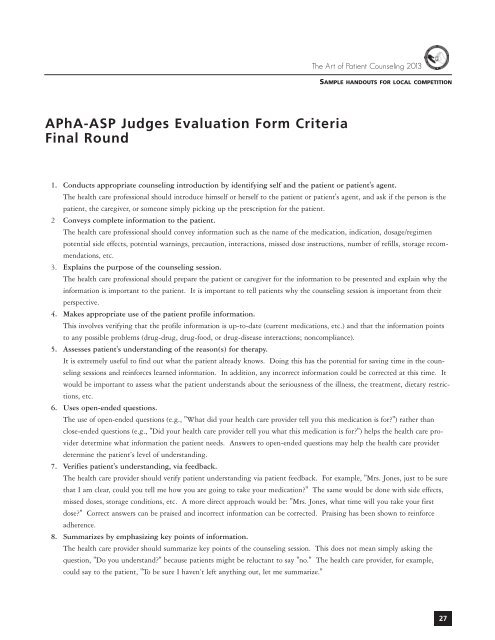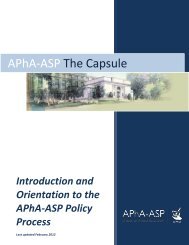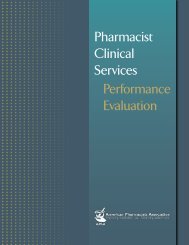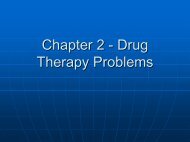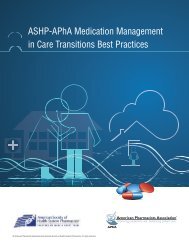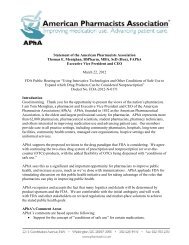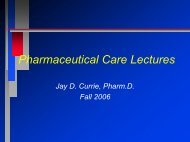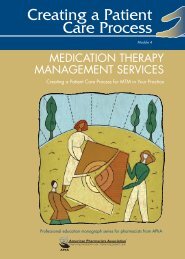the art counseling of patient - American Pharmacists Association
the art counseling of patient - American Pharmacists Association
the art counseling of patient - American Pharmacists Association
You also want an ePaper? Increase the reach of your titles
YUMPU automatically turns print PDFs into web optimized ePapers that Google loves.
The Art <strong>of</strong> Patient Counseling 2013Sample handouts for local competitionAPhA-ASP Judges Evaluation Form CriteriaFinal Round1. Conducts appropriate <strong>counseling</strong> introduction by identifying self and <strong>the</strong> <strong>patient</strong> or <strong>patient</strong>'s agent.The health care pr<strong>of</strong>essional should introduce himself or herself to <strong>the</strong> <strong>patient</strong> or <strong>patient</strong>'s agent, and ask if <strong>the</strong> person is <strong>the</strong><strong>patient</strong>, <strong>the</strong> caregiver, or someone simply picking up <strong>the</strong> prescription for <strong>the</strong> <strong>patient</strong>.2 Conveys complete information to <strong>the</strong> <strong>patient</strong>.The health care pr<strong>of</strong>essional should convey information such as <strong>the</strong> name <strong>of</strong> <strong>the</strong> medication, indication, dosage/regimenpotential side effects, potential warnings, precaution, interactions, missed dose instructions, number <strong>of</strong> refills, storage recommendations,etc.3. Explains <strong>the</strong> purpose <strong>of</strong> <strong>the</strong> <strong>counseling</strong> session.The health care pr<strong>of</strong>essional should prepare <strong>the</strong> <strong>patient</strong> or caregiver for <strong>the</strong> information to be presented and explain why <strong>the</strong>information is important to <strong>the</strong> <strong>patient</strong>. It is important to tell <strong>patient</strong>s why <strong>the</strong> <strong>counseling</strong> session is important from <strong>the</strong>irperspective.4. Makes appropriate use <strong>of</strong> <strong>the</strong> <strong>patient</strong> pr<strong>of</strong>ile information.This involves verifying that <strong>the</strong> pr<strong>of</strong>ile information is up-to-date (current medications, etc.) and that <strong>the</strong> information pointsto any possible problems (drug-drug, drug-food, or drug-disease interactions; noncompliance).5. Assesses <strong>patient</strong>'s understanding <strong>of</strong> <strong>the</strong> reason(s) for <strong>the</strong>rapy.It is extremely useful to find out what <strong>the</strong> <strong>patient</strong> already knows. Doing this has <strong>the</strong> potential for saving time in <strong>the</strong> <strong>counseling</strong>sessions and reinforces learned information. In addition, any incorrect information could be corrected at this time. Itwould be important to assess what <strong>the</strong> <strong>patient</strong> understands about <strong>the</strong> seriousness <strong>of</strong> <strong>the</strong> illness, <strong>the</strong> treatment, dietary restrictions,etc.6. Uses open-ended questions.The use <strong>of</strong> open-ended questions (e.g., "What did your health care provider tell you this medication is for?") ra<strong>the</strong>r thanclose-ended questions (e.g., "Did your health care provider tell you what this medication is for?") helps <strong>the</strong> health care providerdetermine what information <strong>the</strong> <strong>patient</strong> needs. Answers to open-ended questions may help <strong>the</strong> health care providerdetermine <strong>the</strong> <strong>patient</strong>’s level <strong>of</strong> understanding.7. Verifies <strong>patient</strong>'s understanding, via feedback.The health care provider should verify <strong>patient</strong> understanding via <strong>patient</strong> feedback. For example, "Mrs. Jones, just to be surethat I am clear, could you tell me how you are going to take your medication?" The same would be done with side effects,missed doses, storage conditions, etc. A more direct approach would be: "Mrs. Jones, what time will you take your firstdose?" Correct answers can be praised and incorrect information can be corrected. Praising has been shown to reinforceadherence.8. Summarizes by emphasizing key points <strong>of</strong> information.The health care provider should summarize key points <strong>of</strong> <strong>the</strong> <strong>counseling</strong> session. This does not mean simply asking <strong>the</strong>question, "Do you understand?" because <strong>patient</strong>s might be reluctant to say "no." The health care provider, for example,could say to <strong>the</strong> <strong>patient</strong>, "To be sure I haven’t left anything out, let me summarize."27


